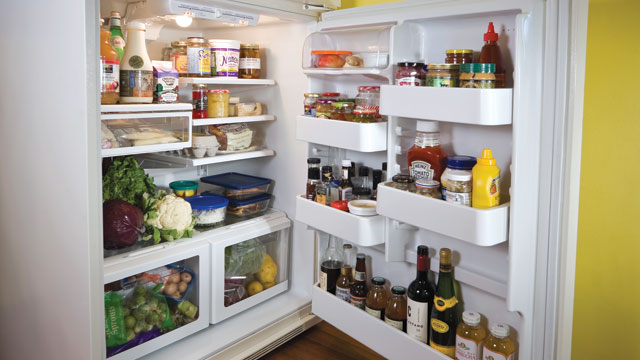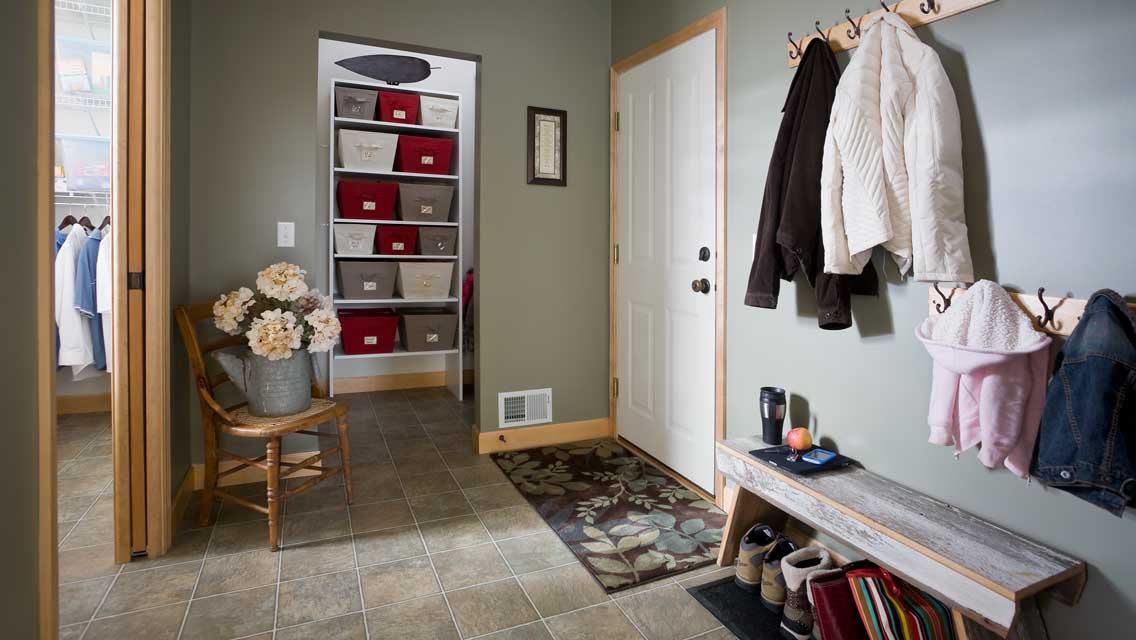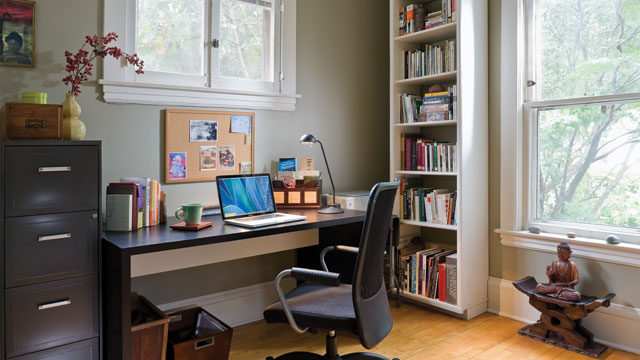Welcome to part three of our decluttering series, “Order out of Chaos.” In this installment, our certified feng shui and decluttering expert Andrea Gerasimo takes on the pantry of Experience Life’s health and nutrition editor, Anjula Razdan.
One of Razdan’s chief complaints was having inadequate clear space to cook for her family. Her other pet peeve: Food wasted as the result of languishing too long in a crowded and chaotic fridge. “Having food go bad is an energetic downer,” says Gerasimo, but it’s almost inevitable in a kitchen that doesn’t support the creative energy or practical tasks of cooking. The goal here, she notes, is to create order and beauty while removing barriers to action. “Whenever we reduce the resistance we experience in daily life,” says Gerasimo, “we increase our sense of freedom.”
1. Real Estate Reclaimed
The “before” scene in Razdan’s pantry cupboards is pretty typical of a busy family kitchen: multiple jars and boxes jammed together in no particular order, making it difficult to see at a glance what’s available.
Gerasimo begins with a “search and rescue” mission, removing everything from the countertops, cupboards and fridge surfaces. She and Razdan sort items into three categories: “keep and organize” (food, containers); “give away” (rarely used gadgets, dishes and small appliances); and “toss”(anything moldy or past its prime — like the eight-year-old bottle of mango salsa that crashes to the floor during sorting).
Next, Gerasimo sets about reclaiming the pantry’s “prime real estate” and repurposing it for frequent uses. A rarely used coffeemaker and blender move from pantry counter to low cupboard, making way for glass jars filled with rice and beans Razdan cooks with regularly, but had been scooping from large bags that lived on the top of the fridge, out of comfortable reach. “We’re striving to create a sense of order here, but also a sense of ease,” says Gerasimo.
2. User-Friendly Systems
The situation in the refrigerator was much like the cupboards: a lot of items packed close, with no system for finding things easily and no receptive space.
Gerasimo’s second mission involves removing the entire contents of the fridge into boxes and separating it into three categories: “keep,” “toss” and “toss after emptying recyclable containers.” An empty fridge is much easier to clean, she explains (the entire interior gets a thorough scrubbing), and also easier to restructure (by changing shelf heights and reorganizing shelves and bins).
Gerasimo’s goal is to set up user-friendly systems: a designated shelf for daily-use items like bread and eggs, a dedicated drawer for greens so they don’t get smashed beneath other vegetables, and a regular spot for leftovers so they get eaten on schedule. Storing leftovers in glass containers makes it easier to identify what you have on hand, Gerasimo notes. Food displayed under glass is also more visually appealing than when it’s stored in plastic or tin foil, and it’s less likely to take on odors or go bad as quickly.
3. Sense of Clarity
Valuable counter space is made available for food prep, and corners, formerly magnets for clutter, are now “defended” by pretty jars of grains and beans. The refurbished pantry hosts a number of user-friendly systems. Shelves are arranged according to frequency of use: The bottom level holds quick-grab items like crackers and tea; staples like pasta, oils and canned beans live on the second shelf; and the top shelves hold “one-grab” items (like spare jars of mustard) that will move to the fridge once opened, or (like sauces) be eaten all at one time. Gerasimo gathers assorted packages of pasta into a basket, making them easy to pull from the shelf and see all at once, while also reducing the risk of spills.
The top of the fridge, which had become a notorious catch-all zone for homeless objects, is cleared and graced by a plant and decorative pitcher, giving the family’s eyes a pleasing place to land on entering — and serving as a gentle reminder that this surface is now off-limits for dumping.
4. Creating Convenience
In Razdan’s fridge, items generally got stuffed wherever they’d fit. Gerasimo’s goal was to give the most frequently used items, like bread, eggs and milk, a “home” where they would be easier to find and reach.
Leftovers occupy the bottom shelf. Beverages are consigned to top, left. Based on Razdan’s real-life needs, the butter shelf in the door now holds quick-grab foods like cut fruit, and the rest of the door stores “inspirational” items, like condiments and sauces, that make her feel more inclined to cook.
Crispers, Gerasimo notes, have a way of putting veggies and fruits “out of sight, out of mind.” Particularly if they’re all jumbled up. Using one drawer for delicate fruits and greens, one for harder veggies, can help. So can storing large, sturdy vegetables like cabbage on the bottom shelf, where they can be easily moved aside to access jars in back. But the real key is actively looking at what you have, she says, both before cooking and before heading to the store. “Set up your kitchen well,” says Gerasimo, “and you’re set to cook and eat well, too.”




This Post Has 0 Comments